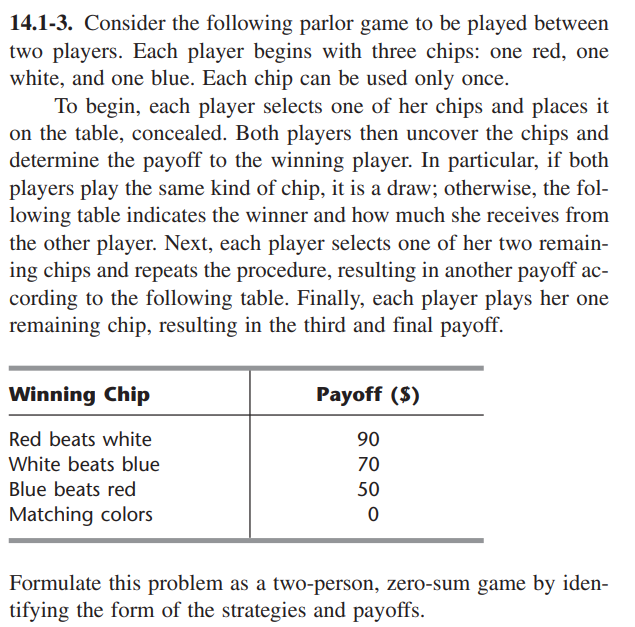14.1-3. Consider the following parlor game to be played between two players. Each player begins with three chips: one red, one white, and one blue. Each chip can be used only once. To begin, each player selects one of her chips and places it on the table, concealed. Both players then uncover the chips and determine the payoff to the winning player. In particular, if both players play the same kind of chip, it is a draw; otherwise, the fol- lowing table indicates the winner and how much she receives from the other player. Next, each player selects one of her two remain- ing chips and repeats the procedure, resulting in another payoff ac- cording to the following table. Finally, each player plays her one remaining chip, resulting in the third and final payoff. Winning Chip Payoff ($) Red beats white 90 White beats blue 70 Blue beats red 50 Matching colors
14.1-3. Consider the following parlor game to be played between two players. Each player begins with three chips: one red, one white, and one blue. Each chip can be used only once. To begin, each player selects one of her chips and places it on the table, concealed. Both players then uncover the chips and determine the payoff to the winning player. In particular, if both players play the same kind of chip, it is a draw; otherwise, the fol- lowing table indicates the winner and how much she receives from the other player. Next, each player selects one of her two remain- ing chips and repeats the procedure, resulting in another payoff ac- cording to the following table. Finally, each player plays her one remaining chip, resulting in the third and final payoff. Winning Chip Payoff ($) Red beats white 90 White beats blue 70 Blue beats red 50 Matching colors
Algebra & Trigonometry with Analytic Geometry
13th Edition
ISBN:9781133382119
Author:Swokowski
Publisher:Swokowski
Chapter10: Sequences, Series, And Probability
Section10.8: Probability
Problem 32E
Related questions
Question

Transcribed Image Text:14.1-3. Consider the following parlor game to be played between
two players. Each player begins with three chips: one red, one
white, and one blue. Each chip can be used only once.
To begin, each player selects one of her chips and places it
on the table, concealed. Both players then uncover the chips and
determine the payoff to the winning player. In particular, if both
players play the same kind of chip, it is a draw; otherwise, the fol-
lowing table indicates the winner and how much she receives from
the other player. Next, each player selects one of her two remain-
ing chips and repeats the procedure, resulting in another payoff ac-
cording to the following table. Finally, each player plays her one
remaining chip, resulting in the third and final payoff.
Winning Chip
Payoff ($)
Red beats white
90
White beats blue
70
Blue beats red
50
Matching colors
Formulate this problem as a two-person, zero-sum game by iden-
tifying the form of the strategies and payoffs.
Expert Solution
This question has been solved!
Explore an expertly crafted, step-by-step solution for a thorough understanding of key concepts.
This is a popular solution!
Trending now
This is a popular solution!
Step by step
Solved in 2 steps

Knowledge Booster
Learn more about
Need a deep-dive on the concept behind this application? Look no further. Learn more about this topic, advanced-math and related others by exploring similar questions and additional content below.Recommended textbooks for you

Algebra & Trigonometry with Analytic Geometry
Algebra
ISBN:
9781133382119
Author:
Swokowski
Publisher:
Cengage

Algebra & Trigonometry with Analytic Geometry
Algebra
ISBN:
9781133382119
Author:
Swokowski
Publisher:
Cengage